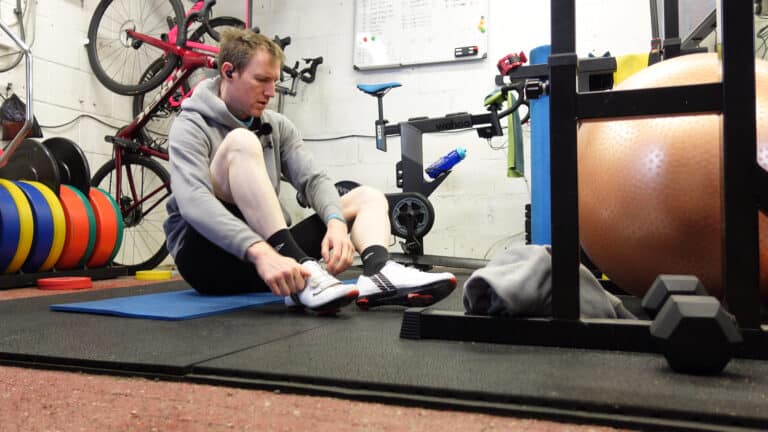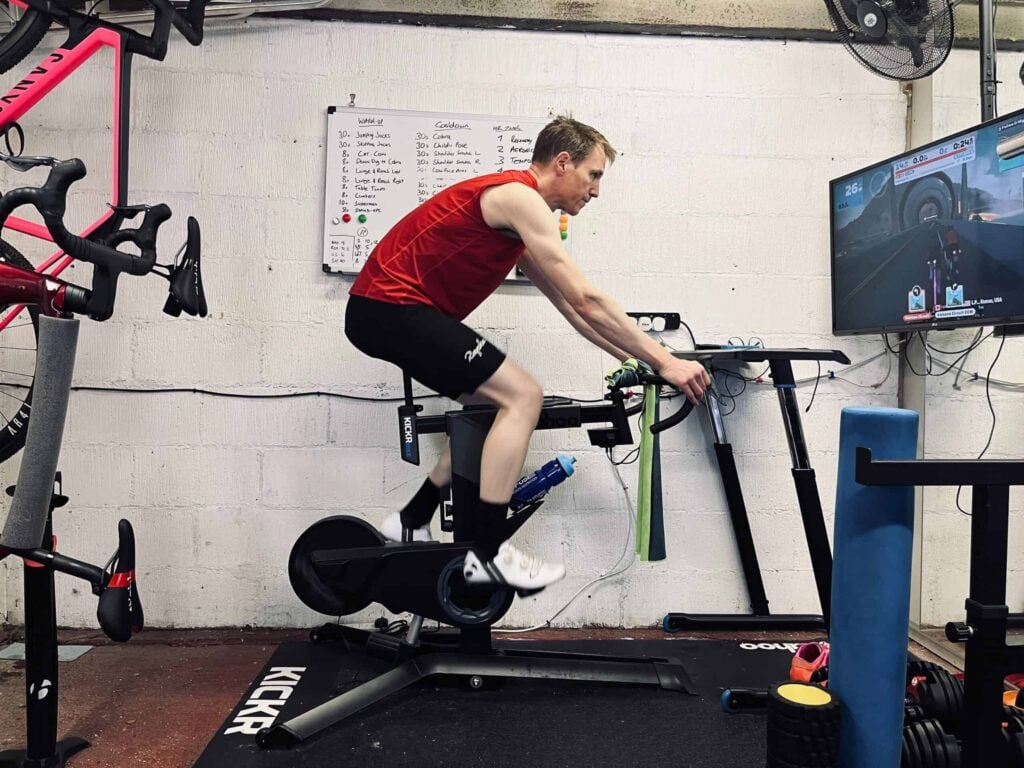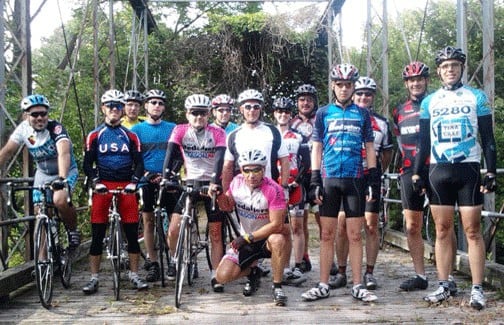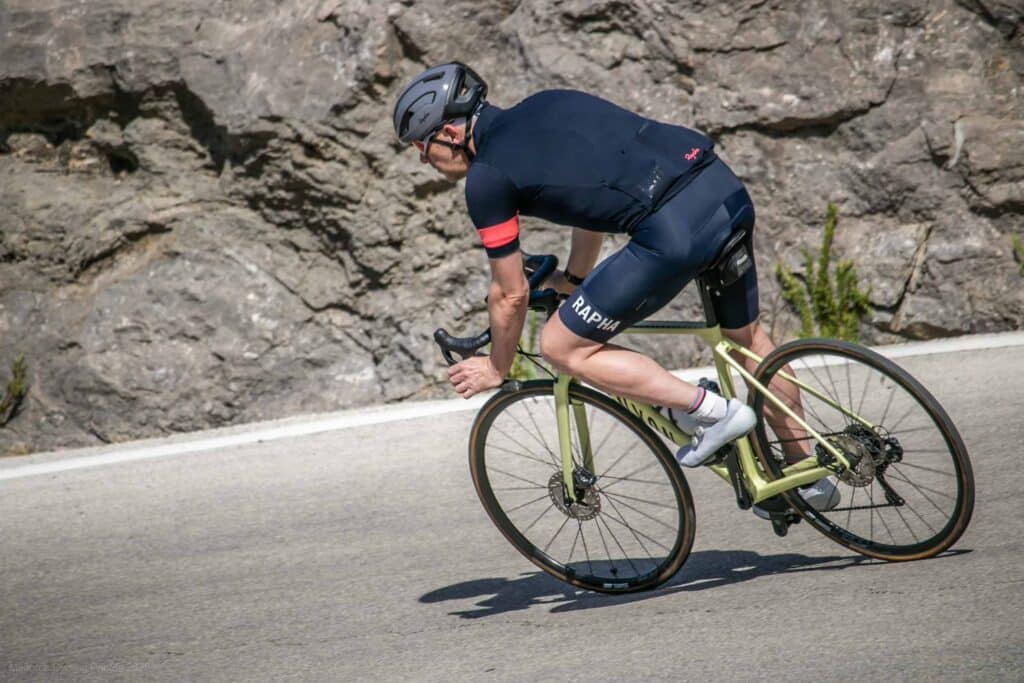Finding ways to increase cycling power, or functional threshold power, can make riders more efficient.
Since the dawn of the bicycle (around 1860), cyclists have challenged one another to races and long-distance events. Britannica says the first recorded bike race was in Paris in 1868 on a Velocipede.
Over time, the bicycle evolved, and with each transformation, athletes pushed the boundaries of speed and endurance.
Nowadays, modern bikes look nothing like their predecessors. With high-tech components and materials, these machines launch cyclists into mind-boggling sprints, cross-country races, and dizzying mountain descents.
And as the machine advanced, so did sports physiology enabling athletes to go faster and further than ever before.
Whether you’re considering going pro, a weekend warrior, or just someone who enjoys club rides, improving your power is paramount to success as a cyclist.
In this post, I’ll dive deeper into the science of getting faster and toss in some power myths, too.
Key Takeaways: 6 Ways to Increase Cycling Power
- Cycling power is measured in watts using a power meter
- The first power meter was invented in 1987 and has revolutionized bike training
- FTP (functional threshold power) is the industry standard for measuring fitness and developing cycling training plans
- Methods to improve power include developing strong aerobic fitness, club rides, strength training, riding into the wind and up hills, and zone training
- Myths abound about improving power that are not only rubbish but can be dangerous

What is Cycling Power?
Cycling power is measured in watts using a power meter. The power meter is a relatively new invention, with the first patent issued in 1987 to Ulrich Schoberer. Today, many cyclists use a power meter to measure and track their watts for zone training.
Before the power meter, cyclists could only base their conditioning on speed and distance. While these are valuable data to review, they didn’t answer the questions coaches and riders sought:
- How can I go faster?
- What workouts improve speed?
A power meter allows coaches and riders to dial in workouts focused on building strength and power. The result is a regimen that takes the guesswork out of the mystique of bike training. But a power meter isn’t enough for developing power.
Like calibrating a medical device, cyclists need a fitness benchmark for their workout starting point. An FTP test is the standard that coaches and cyclists use to acquire this metric.
What is FTP for cycling?
If you checked out my Training Zones article, you’re familiar with FTP or functional threshold power. No worries if you haven’t! FTP is the sustainable power (watts) a cyclist can maintain for one hour. Factors that will impact your FTP are age and current fitness.
While comparing your FTP to others is tempting, it can be demoralizing or turn you into a Class A Jerk if you’re not careful. Remember the adage: “There’s always someone faster and slower than you.”
Instead, remember that your FTP is merely your starting point for a training program and developing power. Focus on that, instead.
You’ll need to take an FTP test, which you can read about in my Training Zones article. Once you have your FTP, workouts can be designed in Peloton, TrainerRoad, and other indoor apps.
Additionally, you can take these essential training sessions outdoors by downloading them into your cycling computer.
Next, let’s discuss six methods to improve your speed, aerobic fitness, and power.

1. Go Slow to Go Fast
Before launching into hill repeats or sprint intervals, you need a strong aerobic foundation. Cyclists often refer to this as “base miles” (aerobic fitness) which are the bedrock for developing anaerobic stamina for intervals and threshold, sweet spot training, and sprinting.
Tour de France winner Greg LeMond stated in his book, Greg LeMond’s Complete Book of Bicycling, that he logged 1,000 base miles at a comfortable pace before attempting speed work. While most of us don’t have the luxury to log that many miles, we can adopt the same principle.
Your initial cycling workouts should be Zone 1 and 2 of your FTP for most of your startup training. After establishing basic fitness, introduce higher-intensity workouts into your routine. Remember, the bulk of your workouts should be Zone 2-3 and not all-out intervals day after day.
No matter where you are in your training, don’t neglect rest days or recovery rides. These are equally important, and if you skip or neglect them, you can hamper your development.
2. Club Rides
Another great way to increase your power and speed is to join area club rides. While social rides are wonderful, you’re looking for group rides based on pace groups. Most clubs list their groups’ average mile per hour on their website, so you know the intensity level.

You’ll need to gather your courage and join a group that’s a bit out of your range to improve your power. Fellow cyclists will talk about it with trepidation and reverence, perhaps adding that it’s doable unless that Cat 1 rider shows up and turns it into a race!
No matter where you live, I guarantee a challenging ride is waiting for you to discover.
While intimidating, these rides have helped me develop speed and confidence. And while every group has that cocky rider, most Fast Cats will take you under their wing and offer tips to get faster on the bike.
Additionally, drafting in a group can help you conserve about 20% of your energy. Appropriately done, drafting translates into going faster than expected, enabling you to hang on even if it’s for dear life!
3. Strength Training
Often overlooked or ignored by the cycling community, strength training can be vital in your cycling workout toolbox. In Cycling + Strength Training, I detail the pros and cons of working out with weights and won’t belabor the topic here.
Note that weight training and cycling workouts can improve one’s power, finesse, core strength, and joint wellness. The goal of strength training isn’t to build muscle like a bodybuilder but to improve power by doing a series of reps with lighter weights.
And if you’re over 40 years old, the sooner you start weight training, the better your overall health and mobility will be for years to come. Once you hit 30, the body begins to, well, start deteriorating. And when you near fifty as a cyclist, you’ll begin noticing:
- Muscles weaken
- You need a longer recovery time
- Bones and joints weaken
- You sweat less (making hot-weather cycling challenging)
- Your brain shrinks
Pretty depressing, isn’t it?! But the good news is cycling and weight training can combat these symptoms and improve one’s standard of living. I hope to discuss the pros and cons of aging as a cyclist in future posts.

4. Racing
Nothing says speed training like racing! And when I say “race,” I’m not referring to an event ride or spirited sportive, but a sanctioned race. USAC offers racing of various degrees across the United States.
To participate, you must sign up for an annual license or pay for a one-day license at the event.
You should be in peak shape to race, and while they are intimidating for first-timers, racing will teach you a lot about yourself, your fitness level, and your bike handling skills.
If you’re uncomfortable being in a tight and fast paceline, join some fast-paced local rides to learn how to do this all-important technique. Racing is NOT the place to learn!
As a newbie, you’ll race in the beginner category 5, or “cat 5” as cyclists in the States call it. Racing falls into three categories:
- Criterium
- Road
- Time trial
Criterium races, or “crits,” are the most abundant forms of racing because they occur on a short, closed course. Instead of racing miles, you compete against the clock around a loop that’s generally 1-2 miles long. Consequently, crits are very fast and often in close quarters.
Road races are the traditional events featured at the Tour de France. The distance varies by racing category, and because the route is longer with less cornering than crit racing, it is perhaps less dangerous and claustrophobic.
Time trials, nicknamed “the race of truth” by fans and pros alike, are a solo ride from point A to point B as fast as possible. While much safer since no other cyclists are nearby, they are challenging as it tests your fitness and mental toughness.
Springboarding from time trials are triathlons. The cycling portion is, in essence, a time trial since drafting isn’t permitted. If you can’t do a full tri, consider coercing friends who swim and run to sign up for a team-time trial.

5. Battle Mother Nature
Hills and wind: a cyclist’s worst nightmare! But let me challenge your thinking. What if you saw them as opportunities to get stronger instead of dreading them?
There’s a saying when it comes to climbing. “Hills never get easy; you just get faster.” And while a cyclist’s physique factors into climbing ability, nothing gets the heart and legs working like a good climb.
Tackle climbing once you have solid base miles under your belt. When you start, practice different tactics.
- Spin at 85-100 rpm in an easy gear. Remain seated and find a gear and cadence to maintain up the incline. This helps build endurance while also developing muscle tone and memory.
- Use a medium cadence (50-75) in a higher gear. Only practice this when in good shape, and find a gear that’s not too taxing on your knees. Experiment with standing and sitting since both use different muscles. Over time, such exercise will improve your power and your body’s ability to process oxygen faster.
- Combo. Mix the easy spin and harder gearing for an impactful workout. This also breaks the monotony on long climbs.
- “Up and over.” Push yourself mentally to reach the summit, roll over, and start coasting downhill. When you become stronger, shift into a higher gear at the summit, and instead of coasting, hammer downhill.
Windy days are another great opportunity to improve your power. Create a course that goes into the wind (I like getting the worst part over first!) and focus on your power output, not speed. Be advised that if you have carbon wheels, they can act like sails on crosswinds, so exercise caution.
Stiff headwinds can imitate climbing because you exert more power, usually for extended periods. I prefer climbing a Cat 4 hill than battling through a 15-mph wind for 20 miles!
Like the combo method of climbing, experiment with cadence, gearing, and power. Use a higher cadence with power output just below FTP for the bulk of your windy ride. Next, shift to a higher gear with a slower cadence to maintain about 10-20% above your FTP for shorter segments.
And don’t forget to enjoy the tailwind home! But focus on your watts and see if you can maintain zone 2-3 power. In short, don’t let the wind do all the work!
6. Zone Training
I went into detail about zone training in this Training Zones article, so if you’re unfamiliar with this technique, read it first.
As discussed, cyclists need a strong aerobic foundation to build power, with most of their training done in zone 2-3. Once established, weave the more intense zones into your workouts:
- Zone 4-Sweet spot
- Zone 5- Threshold
- Zone 6-VO2 Max
- Zone 7-Anaerobic
- Zone 8-Sprint
Zone training can be done on an indoor trainer or outdoors using a downloaded workout visible on your bike computer.
If you’re not into zone training, sprinkle in an all-out sprint with friends, take strong pulls during a club ride, or push yourself up a hill faster than usual. These simulate many zones I just listed and won’t feel as structured as doing zone training regimens.
Debunking Power Myths
Now that you understand how to improve your power let’s examine some myths associated with strength and speed.
- Add Weight. This myth goes as follows: if you attach ankle weights or ride with a backpack full of bricks, you’ll get stronger. While there is a hint of truth, the side effects and danger of following such wisdom are foolish.
Chances are you’ll injure joints, ride erratically, develop poor bike form, and endanger others.
- Purchase a lighter bike. Again, there is some truth to this when climbing, but generally speaking, a more lightweight bike won’t miraculously make you faster. You’re better off focusing on nutrition, a consistent training plan, and working on exercises to improve power.
Sure, if you own a tank like a 70’s Schwinn Varsity, a new bike will help. But then again, Peter Sagan won his first race by borrowing his sister’s bike!
- Power automatically makes you faster. Well, that depends. You could have powerful legs that could squat massive weights, but that doesn’t translate into being a fast cyclist. Chris Froome has the oddest riding form known in the pro circuit, with skinny legs to boot, but has won the TDF a few times!
- I need to lose weight. Once more, this can depend. If you’re obese, losing weight is paramount to a healthy life. And the result would make you faster on a hilly course. Conversely, if you’re a beanpole like me, then losing too much weight is dangerous.
Instead, focus on healthy nutrition and a training plan that builds power versus counting calories or trying to drop a pound or two.
- I’ll never get fast, or I’m too old. Look, there’s no silver bullet or magic pill to take to make you faster and more robust. It takes time, sacrifice, training, and dedication. Perhaps start with “positive talk” that you can improve.
While age does impact the body and mind significantly, it doesn’t have to determine who or what you can accomplish as an athlete. If you doubt me, watch a masters race and marvel at cyclists in their 60s hammering on the tarmac.
Conclusion
Becoming a stronger cyclist is something any rider can accomplish with the proper training program, mindset, and discipline. And with the variety of training options available, there’s a workout program that will work for you!
Developing strength on the bike will help you win races and reap glory on club rides. Power will also enable you to sprint away from a chasing dog or at least be faster than your friend!
